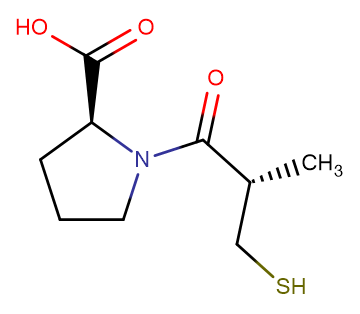
Captopril
CAS No. 62571-86-2
Captopril( SA 333 | SQ 14,225 )
Catalog No. M15369 CAS No. 62571-86-2
Captopril is a potent, competitive inhibitor of angiotensin-converting enzyme (ACE).
Purity : >98% (HPLC)
 COA
COA
 Datasheet
Datasheet
 HNMR
HNMR
 HPLC
HPLC
 MSDS
MSDS
 Handing Instructions
Handing Instructions
| Size | Price / USD | Stock | Quantity |
| 50MG | 36 | In Stock |


|
| 100MG | 43 | In Stock |


|
| 200MG | 53 | In Stock |


|
| 500MG | 73 | In Stock |


|
| 1G | Get Quote | In Stock |


|
Biological Information
-
Product NameCaptopril
-
NoteResearch use only, not for human use.
-
Brief DescriptionCaptopril is a potent, competitive inhibitor of angiotensin-converting enzyme (ACE).
-
DescriptionCaptopril is a potent, competitive inhibitor of angiotensin-converting enzyme (ACE).
-
In Vitro——
-
In Vivo——
-
SynonymsSA 333 | SQ 14,225
-
PathwayEndocrinology/Hormones
-
TargetRAAS
-
RecptorACE
-
Research AreaCardiovascular Disease
-
Indication——
Chemical Information
-
CAS Number62571-86-2
-
Formula Weight217.29
-
Molecular FormulaC9H15NO3S
-
Purity>98% (HPLC)
-
SolubilityEthanol: 43 mg/mL (197.89 mM); Water: 2 mg/mL (9.2 mM); DMSO: 43 mg/mL (197.89 mM)
-
SMILESO=C([C@H]1N(C([C@H](C)CS)=O)CCC1)O
-
Chemical Name(2S)-1-[(2S)-2-methyl-3-sulfanylpropanoyl]pyrrolidine-2-carboxylic acid
Shipping & Storage Information
-
Storage(-20℃)
-
ShippingWith Ice Pack
-
Stability≥ 2 years
Reference
1.Andujar-Sanchez M, et al. FEBS Lett. 2007 Jul 24;581(18):3449-54.
molnova catalog



related products
-
L-162,313
L-162,313 is an ANG II receptor agonist, a nonpeptide that mimics the biological actions of angiotensin II and induces an increase in MAP.
-
Leucylarginylproline
Leucylarginylproline is an?inhibitor of angiotensin-converting enzyme (ACE) (IC50 : 0.27μM).
-
Angiotensin IV
Angiotensin IV is a less effective agonist at the angiotensin AT1 receptor.



 Cart
Cart
 sales@molnova.com
sales@molnova.com


